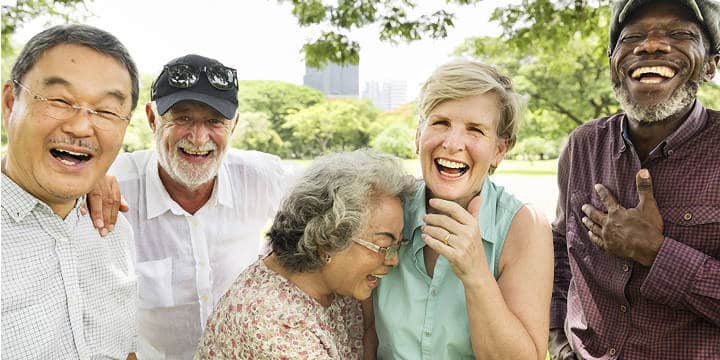

55+ Communities: Information About Active Adult Retirement Living
By Publisher
| Last updated
Today's 55+ communities offer more advantages to active adults and seniors than ever before. They are also easy to find. In fact, chances are good that you currently live near an age-qualified retirement living community. But, even if you don't, it's fun to contemplate the many exciting locations and lifestyle opportunities that such communities are known for. They frequently offer a no-fuss style of living that's ideal for vital adults who want to keep experiencing some of life's greatest joys.
Can you imagine living in a community that feels like a private resort? That's what many people—retirees and non-retirees alike—get to enjoy on a daily basis. They have access to great social and recreational opportunities. They have fewer home maintenance responsibilities. And they frequently live in homes with high-quality features that are optimized for their distinctive lifestyles and practical needs.
So learn more about this type of active adult living. In this article, you'll find answers to several common questions. And you'll discover why this retirement option continues to be popular with many people like you.
What Is a 55+ Community?
In its most basic form, a 55+ community is a residential development that purposely limits the number of residents who are below the age of 55 to less than 20 percent of the community. Most developments of this type feature low-maintenance homes as well as a variety of shared amenities that are important to active seniors and older adults. Other commonly used terms for these kinds of developments include:
- 55-plus communities
- Age-qualified communities
- Age-restricted communities
- Active adult communities
- Planned retirement communities
- Lifestyle communities
Depending on the particular 55+ community, it's possible to buy or rent anything from an apartment, condo, or townhouse to a fully detached single-family home. In addition, many communities are gated for the extra privacy and security of their residents.
Why Do People Choose This Type of Retirement Living?
According to one nationwide survey by MetLife Mature Market Institute and the National Association of Home Builders, the two most frequently cited reasons for moving into a 55+ community are: 1) to live closer to family and 2) to get a home of higher quality. Of course, those reasons don't tell the whole story. When it comes to older adults and active seniors, retirement living in age-qualified communities is also frequently pursued because they want:
- Fewer responsibilities related to home maintenance
- Homes with modern features
- Homes that are purposely designed for aging in place
- More vibrant and active social lives
- Heightened safety and security
- Easy access to fun and organized recreational activities
In essence, a lot of people find 55+ communities appealing because of the opportunity to live a more carefree or upscale lifestyle. Some people choose to live year-round in such communities, whereas others choose to live in them only part of the year. For example, many retired seniors choose to become "snowbirds." That is, they may have two residences: one in a region that's cold in the winter and one in a 55+ community that benefits from being in a warmer climate. Over the winter months, most snowbirds move to their sunnier residences.
Seniors who are single can also benefit from living in a retirement community. For those who are looking to find companionship, living in a community with other senior singles can make it a lot easier to meet potential love interests. Depending on the amenities your particular community offers, you may not even need to leave to go on a date. You might even be able to attend speed dating events for seniors right where you live. And seniors who prefer to stay solo can find like-minded individuals to form strong friendships with.
What Kinds of Amenities Do 55+ Communities Offer?

Every 55+ community is a little different, but many of them provide amenities that are designed to create a resort-like atmosphere. That's why it's often possible to find active adult communities near scenic open spaces or bodies of water. Depending on the particular community, it's also possible to benefit from amenities such as:
- Homes with covered patios and/or screened porches
- Homes with extra-large master bedrooms, walk-in closets, and en-suite bathrooms
- Community-exclusive security patrols and/or gated systems
- Fitness facilities that feature a variety of exercise equipment
- Outdoor swimming pools and/or indoor pools and spas
- Golf courses, tennis courts, softball fields, and other recreational areas
- Community parks and/or access to exclusive beaches or waterfront areas
- Walking, jogging, biking, and hiking trails
- Community clubhouses with event facilities, craft rooms, and game rooms
- Organized activities like cooking and yoga classes
- Community shopping areas and restaurants (on-site or nearby)
- Libraries and places of worship (on-site or nearby)
- On-site health services
Some 55+ communities even have their own theaters. And some organize their own weekly farmers' markets. In fact, some active adult communities are so large that they are literally towns unto themselves, complete with everything you would find in a city of 30,000 to 100,000 residents.
What Is the 80/20 Rule?
By federal law, at least 80 percent of a 55+ community's homes must have, at minimum, one resident who is 55 or older. Each individual community generally gets to decide how to handle the remaining 20 percent. As a result, some communities will allow a small number of younger adults to become residents. They also may allow younger adults to remain in their homes if their older spouses, partners, or parents pass away while living there. However, most 55+ communities prefer to keep the number of 55+ residents as close to 100 percent as possible.
This 80/20 rule stems from an exception to the federal Fair Housing Act known as the Housing for Older Persons Act (HOPA). Because of that federal law, 55+ communities are not considered to be acting in a discriminatory way by restricting occupancy based on the age of their residents. But they do have to follow certain requirements, including the 80-percent rule. If they don't, they can permanently lose their age-restricted status.
What Are the Most Popular Regions for Active Adult Community Living?
If you're like a lot of people, you probably think of sunny places like Florida and Arizona. But great 55+ communities are now located throughout the U.S. And more are being developed every year. In fact, many of them are being constructed in regions that aren't necessarily known as popular retirement destinations. That's because a lot of older adults and active seniors prefer to live in the regions they already call home.
Even so, some regions are better known for having active adult communities than others. And, increasingly, they aren't just places with year-round sun and warmth. For example, some of the most popular states for this kind of retirement living are:
- Florida
- Nevada
- Arizona
- California
- North Carolina
- South Carolina
- Texas
- Georgia
- Tennessee
- Colorado
- Delaware
What Should I Consider Before Choosing a Particular 55+ Community?
Deciding to buy or rent a home in an age-restricted community is a major step toward achieving the new lifestyle you want. That's why it's important to consider a variety of factors that may influence your decision. The more you know ahead of time, the more likely it is that you'll actually be able to experience the kind of life you're after. So, for example, ask yourself questions like:
- What's my budget? These days, it's fairly easy to find homes in 55+ communities that can match almost anyone's budget. But it's vital to have a good handle on exactly what you can afford. When you explore the potential costs, remember to consider any additional expenses such as yearly or monthly resident fees. Some of the most luxurious communities also have equity memberships, which are ownership stakes that require an extra financial investment. And don't forget to consider how much you're likely to pay in local taxes.
- What are the community's rules and covenants? Every 55+ community is going to have some type of homeowners' association that governs what's allowed and disallowed. It's there to help ensure that home values are maintained and that residents stay safe and socially engaged. As part of that role, it will implement and enforce various restrictions. So it's wise to find out exactly what those restrictions are before moving in.
- What are my potential neighbors like? Your future social life is too vital to overlook. You'll probably want to feel welcomed and comfortable with being yourself. So try to get a sense of the general vibe and personalities of residents in the community. Do you think your own perspective on life will be at home there? Talk with some current residents and find out. Also, remember that more and more niche communities are popping up. For example, it's now possible to find LGBT-friendly communities as well as places for self-described hippies.
- Am I ready to live in a different climate? If you're thinking about moving far away from your current home, then it's important to know what it will really be like to live in your new location. Weather is a big part of that, especially if you'll be a year-round resident. If you can, spend some time acclimating to the climate. Rent for a little while before buying property. Make sure you're OK with how each season feels. (Sometimes, people only visit a region during its peak tourist season, so they don't get the benefit of seeing how things may change over the course of an entire year.)
- Does the community offer activities that I care about? One of the main points of moving into a 55+ community is that you'll get to enjoy more of the things you like doing. So make sure that any community you're considering offers the activities you want to partake in. And find out how often recreational facilities are open for general use versus for organized classes or activities.
- How far will I have to go for medical care? The answer may be very different for every community you look at. In some large communities, certain on-site health care services might be available. In others, medical facilities may be as little as five minutes or up to 45 minutes away. But if you're considering a 55+ community in a remote region, then you may want to find out if it has a designated area for supporting emergency medical airlifts.
- Is right now the best time to buy? This question is particularly relevant if you're exploring options in a region that's popular with tourists and snowbirds. In a location like that, home sellers often drop their asking prices when the peak season ends since they'll have fewer potential buyers during the lull.
Beyond the factors above, your decision may just come down to how a particular 55+ community makes you feel. Can you imagine being happy there? Does it truly represent an opportunity to start thriving in the way that you've been looking forward to? You deserve to make those lifestyle goals happen.

